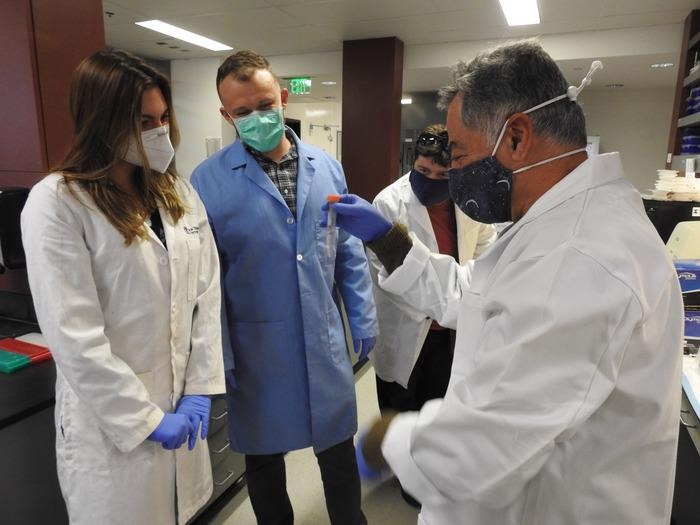Many people believe tuberculosis (TB) is a disease of the past. Nonetheless, it claims over a million lives each year. Furthermore, the problem is escalating as Mycobacterium tuberculosis—the pathogen that causes tuberculosis develops resistance to the antibiotics used to treat the disease.
 Anna Scavo, Sam Modlin, Derek Conkle Gutierrez and Faramarz Valafar, members of the SDSU Laboratory for Pathogenesis of Clinical Drug Resistance and Persistence. Image Credit: Susanne Clara Bard, San Diego State University
Anna Scavo, Sam Modlin, Derek Conkle Gutierrez and Faramarz Valafar, members of the SDSU Laboratory for Pathogenesis of Clinical Drug Resistance and Persistence. Image Credit: Susanne Clara Bard, San Diego State University
Scientists at San Diego State University and their colleagues have discovered rare genetic markers in M. tuberculosis that could aid in the early diagnosis of drug-resistant strains of the disease and aid in the prevention of their propagation.
Health professionals culture samples of mucus from the respiratory tract and bombard them with antibiotics to determine if someone has a distress of tuberculosis that will no longer communicate to primary therapy.
But because TB grows so slowly, that takes weeks. In those weeks that patient is going around spreading TB that might be antibiotic-resistant.”
Faramarz Valafar, Professor, Public Health, San Diego State University
According to him, molecular diagnostic tools are much quicker. These tests look for similar genetic markers of drug resistance and enable more immediate care. However, TB strains with uncommon resistance mechanisms that lack basic genetic markers continue to elude molecular detection.
As a result, clinicians mistakenly believe that conventional TB drugs will destroy the bacteria.
“And so the patient is given the wrong medications and continues to infect others for weeks—sometimes months—before they realize that these drugs aren’t working. So we really want to prevent that,” Valafar added.
Derek Conkle-Gutierrez, a doctoral student in Valafar’s lab, undertook the hunt for rare genetic mutations linked to resistance. The researcher gathered M. tuberculosis samples from seven countries where antibiotic resistance is prevalent. Culturing the samples disclosed that some were undoubtedly drug-resistant, even though molecular diagnostics had missed them.
First we confirmed that they didn’t have the known markers and then we started looking for what other mutations are showing up exclusively in these unexplained resistant isolates.”
Derek Conkle-Gutierrez, Doctoral Student, Valafar’s Laboratory
The scientists found a set of rare genetic mutations that prevent the common TB drug kanamycin from interrupting the pathogen’s ability to synthesize the proteins it requires, making the drug harmless to the pathogen. Another collection of mutations could have the same effect on the TB drug capreomycin.
The research was funded by the National Institute of Allergy and Infectious Diseases (NIAID) and appears in the journal Antimicrobial Agents and Chemotherapy.
Next steps
This manuscript identifies potential markers; confirmatory work for the selection of markers for the next generation of more comprehensive molecular diagnostic platforms lies ahead.”
Faramarz Valafar, Professor, Public Health, San Diego State University
Considering the progression of antibiotic resistance, Valafar believes molecular diagnostics will need to be updated regularly and customized to different parts of the world where antibiotic resistance in tuberculosis is prevalent. Conkle-Gutierrez completely agrees.
“The practice of going in and really looking for these unexplained cases, bringing them in, sequencing them, is a large, expensive project, but it needs to be done to find these rare cases so that they don’t slip through the cracks and spread, causing more antibiotic resistance that just goes undetected.”
The widespread use of life-saving antibiotics may have converted medicine in the twentieth century, but bacterial pathogens, such as M. tuberculosis, quickly escalated resistance. This is because the bacteria strains that withstand the pressure of these powerful drugs have mutations that enable them to endure and expand. The use of antibiotics in livestock and for non-bacterial diseases in humans, like those caused by viruses, exacerbates this.
Close to home
A quarter of the world’s population is thought to be infected with tuberculosis, which has two stages: latent and active. Most people remain symptom-free and are not virulent because their immune systems keep the bacterial load in the inspection. Approximately 10% of these infections progress to active TB. Patients will then develop symptoms and may spread the disease to others.
According to Valafar, many people in this country have latent tuberculosis. He pinpoints, “It is a very important public health concern for the United States as well.”
“The fear is that other pulmonary infections like COVID could overwhelm the immune system and trigger TB to go into its active phase. If this happens, TB will become a bigger problem in the Western world as well. We have already seen this in HIV co-infections,” Valafar adds.
Finally, an effective tuberculosis vaccine is desperately needed. Until then, enhancing molecular diagnostics for antibiotic resistance identification is critical for morbidity control. To that end, Valafar’s lab lately received a new grant from the National Institute of Allergy and Infectious Diseases to sequence drug-resistant tuberculosis from contaminated lung tissue.
“And that will break through some barriers that the tuberculosis research community has been facing,” he said.
SDSU Researchers Identify Rare Genetic Markers of Drug-Resistant Tuberculosis
Anna Scavo, Faramarz Valafar and Sam Modlin, members of the SDSU Laboratory for Pathogenesis of Clinical Drug Resistance and Persistence. Video Credit: San Diego State University
Source:
Journal reference:
Conkle-Gutierrez, D., et al. (2022) Distribution of Common and Rare Genetic Markers of Second-Line-Injectable-Drug Resistance in Mycobacterium tuberculosis Revealed by a Genome-Wide Association Study. Antimicrobial Agents and Chemotherapy. doi.org/10.1128/aac.02075-21.